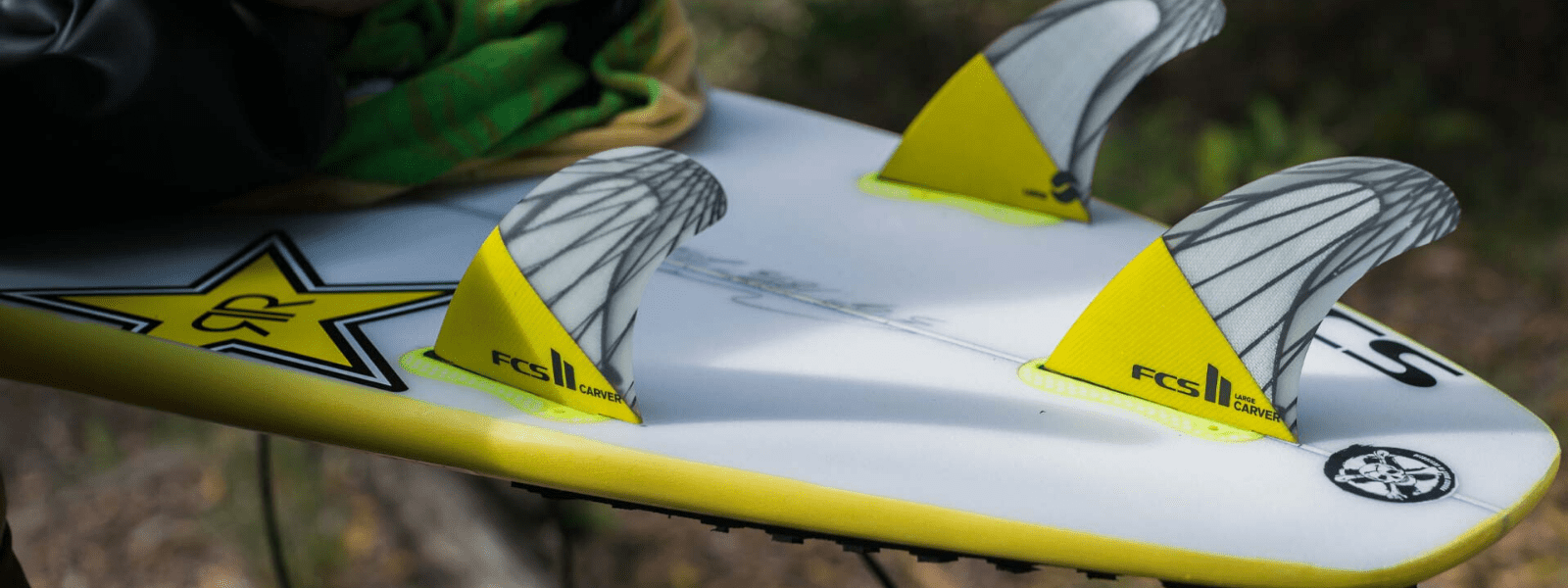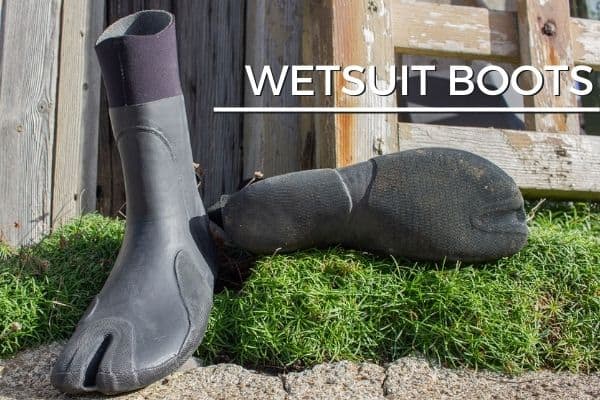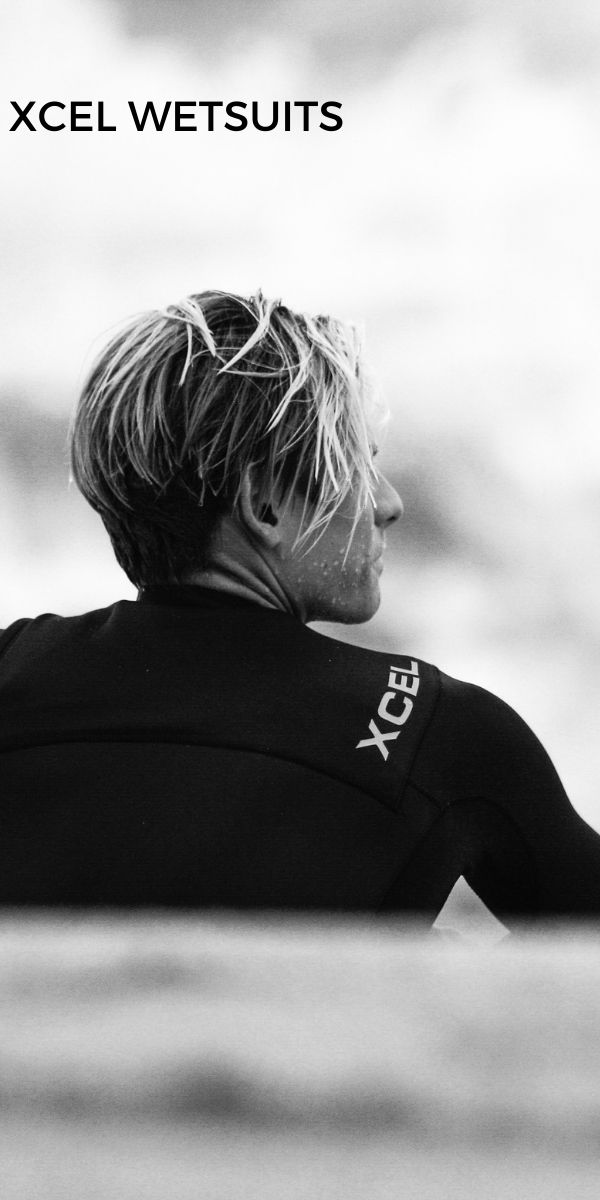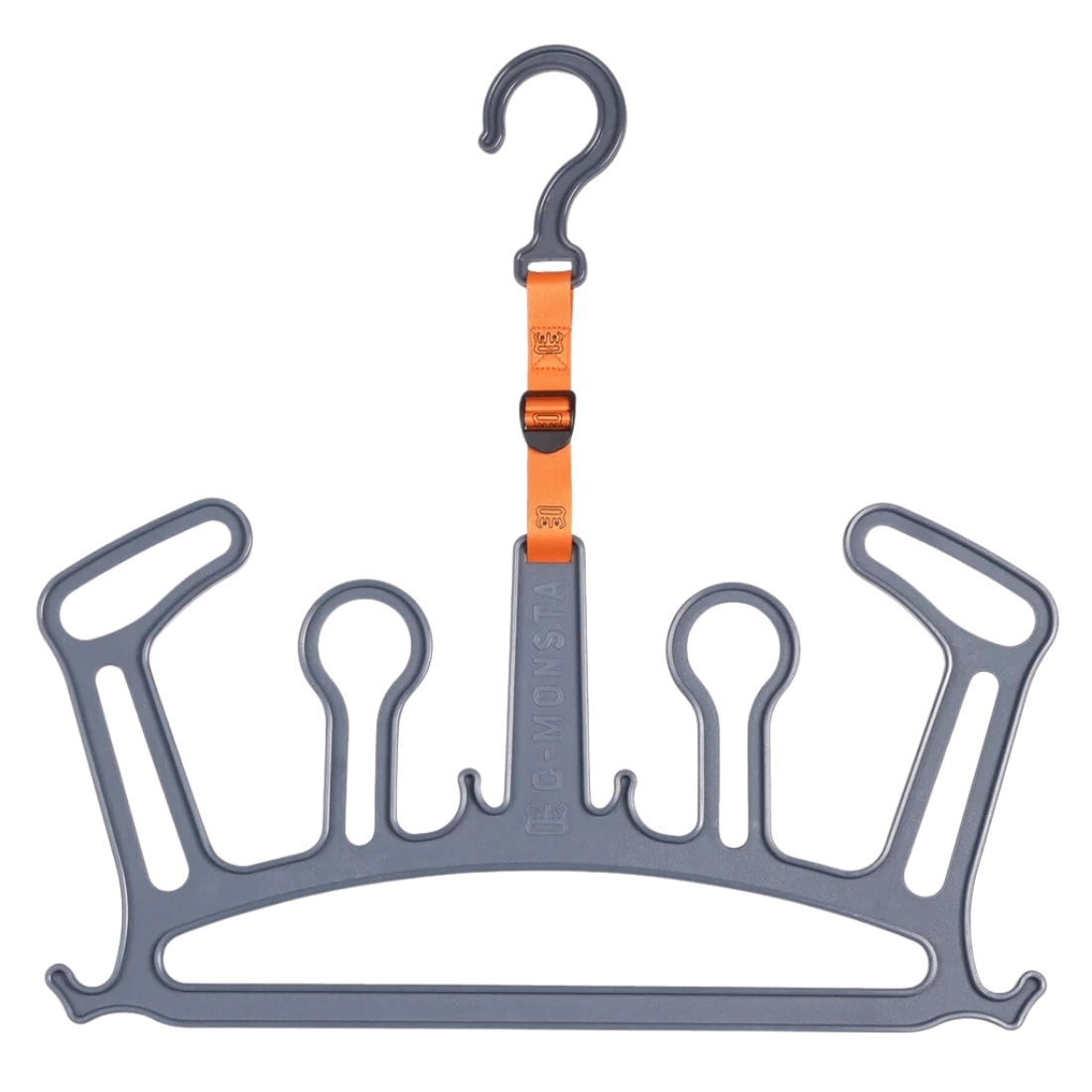
Everything About Surfboard Fins Explained - The Complete Guide to Fin Types, Setups, Constructions & Technical Aspects to Help You Choose Correctly & Shred Harder
Shortcut Links
 Surfboards are not complete without fins. They play a tremendous role on a surfer’s performance on the specific board he rides, so the choice of fins for every board will have a variety and level of impact. With plenty of options on just surfboards alone, it is essential to choose the right board for the riding conditions you prefer. Once this is established, it’s time to choose fins for your surfboard.
Surfboards are not complete without fins. They play a tremendous role on a surfer’s performance on the specific board he rides, so the choice of fins for every board will have a variety and level of impact. With plenty of options on just surfboards alone, it is essential to choose the right board for the riding conditions you prefer. Once this is established, it’s time to choose fins for your surfboard.
Many surfers start by testing the fins they find and this process is never-ending since there are so many fins out there to choose from. Prior to testing any fin, it is essential that you have knowledge about them in order for you to choose the ideal ones for your build and riding style as well as preferred wave conditions.
What are the Different Types of Surfboard Fins?
There are two types of surfboard fins available in the market – glassed-in and removable fins. The need for these fins is basically dictated by the type of board you have. Surfboard shapers make boards with either glassed-in fins or fin box for removable fins, so knowing the type of board will help you decide on the right fin/s for you.
Glassed-In Fins– If you have seen some of the classic retro style surfboards, you are most likely familiar with glassed-in fins. These fins, if laminated properly into the boards, are more structurally sound since the entire base becomes part of the surfboard. Experienced riders who have used glassed-in fins can tell the difference in their performance and attribute this to the way the fins flex with the board.
The modern times have commanded more innovative fins especially when it’s time to travel, replace or upgrade one’s fins. Glassed-in fins have stepped back since the introduction of removable fin systems since they are difficult to replace when they break; they cost more due to repair or replacement; they are not adjustable; and they are not practical for stocking, travelling and transporting.
Removable Fins – The most widely accepted fins nowadays are removable from the bottom of the surfboard. The 1990’s paved the way for removable fins and its mainstream use, thanks to the innovations in fin technology. However, the idea of removable fins was realized in the 60’s by none other than the shapers themselves. They knew how challenging it was to store, ship and repair glassed-in fins back then, so the shift to removable fin setup was the inevitable step.
Compared to glassed-in fins, removable fins are designed and made for fin boxes which are laminated into the boards. These fin boxes have grooves that perfectly match specific fin brands; but the fin options are endless, so surfers can change the size, shape and style based on their preferences.
On the original FCS 1 fins system uses a ‘fin key’ which works like a screwdriver/allen key or hex key is used to secure the fin into the fin box. The one exception to the rule here is the FCS II fin system which has tool less clip in clip out function for rapid fin changes.
Removable fins have made it easier for surfers to alter, update and upgrade their fins in a matter of minutes. They are more manageable, cost-effective, customisable and portable – making them quite beneficial most especially during travels and when storing surfboards that are not in use.
Board Fin Configurations
The option to change and update the fins on your board is made possible by the fin boxes embedded near the board’s tail. Depending on your choice of board (and the number of fin boxes it comes with), the range of fin configurations (or fin setups) can start from one fin to five fins. Choosing the ideal fin configuration will depend on your riding style and experience, as well as the goals you’re after while surfing.
Below are the most common fin configurations that many of today’s surfers are experimenting with to challenge their skills and to up their performance in the water:
Single Fin – Traditional retro style surfboards and longboards are typically the ones that come with a single fin setup. You will find many single fin boxes that allow adjustments where you can move the fin either forward or backward for varied riding experiences.
Single fin setup is ideal for relaxed surfing experience with limited turning (albeit a high level of pivoting). It is generally ideal for speedy, straight shot riding that offers stability, predictability and control over your surfboard.
Twin Fins – Also known as ‘dual fins’, twin fins or twinnies are chosen for boards to make them more manoeuvrable and fun to ride on. However, these fins are not ideal for big wave surfing and they are often used on shortboards and fishes to improve their riding speed. On the upside, a twinny setup can provide prolonged turns and skatey experience.
Thruster – Perhaps the most popular and widely used fin configuration is the thruster. Thruster or ‘tri fins’ are popular among all types of surfers because they perform exceptionally well as they provide stability and control.
This setup consists of three fins – two outer fins and one symmetric inner centre fin – and can be found on surfboards of all shapes and sizes. The two outer fins are positioned closer to the centre of the board and ‘toed-in’ or angled towards the centre. They can be flat or foiled on the inside to enhance water tracking and speed.
Quad – The ideal fin configuration for smaller surf is the quad. This setup is made of four fins – two outer and two inner fins – which provide excellent speed by channelling the water towards the end of the surfboard; thus, offering superb acceleration.
The two inner fins of a quad setup provide excellent speed, while the two outer fins provide superb stability. Quad fins are perfect for generating drive through turns.
Quads have also proven to be amazing in big hollow waves of consequence when paired with an appropriate pin tailed board.
Five-Fin System – The five-fin setup on a surfboard is basically preferred for customisation and flexibility. This configuration is not designed for surfers to use all five fins at the same time (unless they are pairing a quad setup with a knubster rear fin for added stability), but generally provides an option to either have a twin, thruster or quad setup. It is also ideal for surfers with various riding styles and prefer diverse water/wave conditions.
Two + One Fin System – If you have used a longboard, the ‘two + one’ fin configuration is the typical setup. While it may seem like a thruster fin setup, this configuration has a larger centre fin box for a larger longboard fin which allows surfers to adjust to their desired position. The ‘two + one’ setup is quite common for funboards, SUPs, eggs and performance longboards.
Elements of Surfboard Fin Design
A surfboard’s performance is the result of a variety of elements. Collectively, these are fin dimensions and geometry, and they have direct impact and effect on the way you ride and how your board performs in the water.
Rake – Also known as ‘sweep’, the rake is the measurement that defines how far back your fin curves relative to its base. The fin’s rake is, essentially, what drives your board. Fins with larger rake can provide greater speed, more predictability and longer drawn out turns, but not ideal for short tight turns. Fins with less rake can provide a ‘bouncy’ experience while allowing you to make tighter more pivotal turns in steep tight sections.
Cant – The degree wherein the fin sits relative to the surfboard’s base is called the cant. For instance, a fin that’s straight has a cant of 90 degrees which allows you to ride faster by carving through waves more easily. A surfboard is more likely to be responsive when the cant is beyond 90 degrees. On the other hand, less cant enables better drive and acceleration.
Toe – The fin’s toe is the angle of the fin box relative to the centre stringer. It is quite common to describe side fins being ‘toe-in’, which means the frontside of the fin is angled-in closer to the stringer. This causes water to pressure the outer side of the fins which makes a more responsive surfboard-to-rider input.
Foil – The shape of the fin is designed to look aerodynamic with the thickest section in the middle and the thinnest portion runs along the outer edges – this is referred to as the foil. A fin’s foil has a huge impact on how water flows underneath the surfboard, and it’s essentially designed to help propel the board in various waters or wave conditions.
Not all foils are alike in terms of the type of fin they are made with. Single or centre fins are foiled on all sides, while side fins (typically) are foiled only on one side and flat on the other but sometimes with a reverse inside foil for added speed and drive in weaker mushier waves.
Base Length – The widest point of a fin’s outline is called the base. Base length directly affects how a surfboard turns and drives through the water. Longer base length provides more surface area, allowing the board to push against the water with stronger turns and increased drive. Larger fin base, somehow, hinders the board to make sharp turns. Fins with shorter base length are best for surfers who prefer this situation.
Flex – A surfboard fin’s flex plays a significant role on how it performs. More flexible fins are not usually recommended for beginners because they are more challenging to handle and difficult to control. Flexible fins have higher maximum flex which makes the board constantly responsive to the rider’s input.
On the other hand, stiff fins are ideal for newbie surfers since they are more tolerant and have more stability. The lack of (or at least minimal) flex eliminates the possibilities of making sharp turns, but allows for wider and more sweeping turns. Stiff fins also tend to revert swiftly to its normal position, resulting to quicker turns.
A general rule of thumb is this. Fins with a higher flex pattern perform better in small weak waves and stiffer fins in large powerful and hollow surf.
Height/Depth – Fin depth is essentially how deep a fin reaches into the water and it is measured from the board’s bottom to the fin’s tallest point. The way a surfboard turns and how it retains stability in the water are impacted by the fin’s depth. Taller fins usually have more hold or grip in the water which provides surfers more control. Shorter fins may not have the same grip, but they let the board slide-out a bit, which some riders appreciate.
Get to Know More About the Top Surf Fin Brands FCS and Futures
Fin innovations have always fascinated surfers and fans alike. Various brands have their own specialised construction and technology in creating fins that will meet the riding requirements of today’s surfers.
Two of the world’s most popular and well-respected fin brands are FCS and Futures. Both are known for producing some of the industry’s most innovative and rider-focused fins. Let’s have a more in-depth look at what these fin brands offer in terms of construction and sizing that every surfer should be familiar with.
FCS Fins
FCS Fin Size Guide
|
Fin Size |
Rider’s Weight (Kilograms) |
Rider’s Weight (Pounds) |
|
Extra Small (XS) |
Under 55 Kg |
120 Lbs |
|
Small (S) |
55 – 70 Kg |
120 – 155 Lbs |
|
Medium (M) |
65 – 80 Kg |
145 – 175 Lbs |
|
Large (L) |
75 – 90 Kg |
165 – 200 Lbs |
|
Extra Large (XL) |
Over 85 Kg |
Over 190 Lbs |
FCS Fins Scale
(simplified version based on FCS Fins Scale diagram)

To summarize the FCS fins scale, this shows that more flexible fins produce a whipping action which aid lighter and more agile riders in generating speed through turns. Stiffer fins enable stronger and heavier riders to push hard through turns without suppressing the fins.
FCS Fin Construction
FCS offers a variety of fin construction that can meet the varying needs of beginner, intermediate and more advanced surfers. Let’s have a look at the different FCS fin construction:
Neo Glass – These fins have moulded, lightweight fibreglass construction made for pro standard performance. These are typically stiff, responsive fins with engineered foils for consistent riding experience in various water conditions.
Neo Carbon – Extremely lightweight and precision moulded using long-strand carbon and highest-grade European resin, Neo Carbon fins provide firm ‘spring loaded’ flex. These fins enable riders to generate speed in smaller water conditions via ‘whipping effect’ that drives the board from one turn onto the next.
Performance Core – FCS fins that feel like classic fibreglass, but lightweight and with added performance are made with Performance Core. This fin construction uses Resin Transfer Moulding (RTM) process which results to lightweight, smooth and impressive-looking fins with outstanding flex.
Performance Core + AirCore – These fins feature pressed polyurethane foam and AirCore technology that essentially mimics a fin’s geometric foil with the benefit of reduced fibreglass that’s usually required in the RTM process. They are much lighter and allow total fin manipulation.
Performance Core Carbon – FCS fins constructed with Performance Core Carbon are made with hand-laid carbon fibre that’s designed to provide controlled flex and improved base stiffness.
Performance Glass – This fin construction has the material qualities and flex pattern identical to classic fibreglass fins. Performance Glass fin construction offers stiff base, understated responsive tip flex, superb aesthetics and proven robustness. They are also ideal ‘transition fins’ for riders who are converting from fixed fins to the more convenient, accurate and high-performing FCS fins.
Glass Flex – Developed to imitate the memory and flex properties of hand-laid fibreglass, Glass Flex construction also offers better tip flex, minimal base flex, stiffness and noteworthy flex memory. This fin construction involved precision injection moulding to ensure the maximum level of accuracy in configuration for every fin produced.
Soft Flex – Fins made with Soft Flex construction are moulded using extremely flexible urethane. These fins are ideal for softboards and beginner surfers who are building their skill and confidence in the water.
Futures Surfboard Fins
Futures Fin Size Guide
|
Fin Size |
Rider’s Weight (Kilograms) |
Rider’s Weight (Pounds) |
|
Extra Small (XS) |
34 – 53 Kg |
75 – 115 Lbs |
|
Small (S) |
48 – 70 Kg |
105 – 155 Lbs |
|
Medium (M) |
65 – 88 Kg |
145 – 195 Lbs |
|
Large (L) |
80+ Kg |
180+ Lbs |
Futures Fins Scale & Ride Number
(simplified version based on Futures Fins Scale diagram)

To summarize the Futures Fins Scale and Ride Number, the higher ride numbers (10-7) are ideal when you’re pumping; whereas, the lower ride numbers (4-1) are ideal when the waves are pumping. If you want an all-around riding experience, it’s better to go for fins with mid-range ride numbers (7-4).
Futures Fin Construction
Futures fins are ever-evolving particularly when it comes to fin construction. They have multiple options in designing each and every fin series based on their purpose, ride number and performance. Below are the details of Futures fin series and their respective construction:
Blackstix – One of the predominantly known fins in the Futures “speed generating” category is Blackstix. It is notable for being a reliable fin for generating speed and a more dynamic board feel. The latest Blackstix fins have a sustained ride number range of 10-7 and they are designed with highly innovative materials for improved performance.
- Unidirectional Carbon – Specifically for Blackstix 3.0, they have added two layers of unidirectional carbon to the fin’s base at an angle that regulates the way the tip of the fin rotates and bends. This makes the Blackstix 3.0 to have the similar springiness of Blackstix 2.0, and it also enables it hold better through power turns.
- 12 Carbon – Asymmetrical carbon panels on both sides of the fin with the carbon inside completely up to the tip and on the outside just partially up to the tip of the fin. This construction enables the fin to progressively flex and makes your board ’snappy’.
- Epoxy Resin – What makes Blackstix the fastest and lightest fins in the world is the addition of epoxy resin. Epoxy resin is tougher, more resilient and lighter compared to polyester resin, and more importantly it releases 50-75% fewer volatile organic compounds into the environment.
- V2 Foil – The curved feel near the fin’s base and trailing edge make up the most important aspect of the V2 Foil. This creates an effortless rail-to-rail linkage that allows riders to keep their speed while building up big manoeuvres subsequently, even in the absence of powerful waves.
Generation Series - The Futures Generation Series provides speed generating fins that allow surfers to take control no matter the speed. These fins typically have ride numbers between 9 to 7, and said to have more drive and stability.
- V2 Foil – Speed generating fins utilise the power of Futures V2 foil to improve efficient water flow. Even in the absence of strong waves, V2 foil construction enables smooth rail-to-rail linkage so you can manoeuvre and reach your peak performance.
- Uni-Fibreglass – The unique orientation of multi-layered unidirectional fibreglass creates controlled tip flex dynamics for the Generation Series fin. Uni-fibreglass provides more spring and woven with strands of visible poly-fibres to generate more control and strength in the fin’s tip.
- Unidirectional Carbon – For quick response and vertical strength, unidirectional carbon is added: vertically across each front-half of every fin. They work like spines which in return secures the fin’s leading edge and concentrates the tip’s flex, providing the fin a snappy transitional turn.
- Epoxy Resin – Epoxy resin adds another layer of performance to Generation Series fins. Compared to polyester resin, this material is lighter and more resilient which makes it possible for the Generation Series fins to be more responsive, speed-generating, and able to retain control.
- Bi-Directional Carbon – Providing a solid base and enabling the fin’s tip to retain resilience, Bi-directional 12K carbon panels cover the inner and outer base areas of the fins.
Alpha – Futures’ remarkable innovation in developing unique materials is clearly represented in the Alpha series. Fins in this series, under the Balanced category and ride number 7-4 are extremely lightweight and resilient. Alpha series fins are made with moulded carbon fibre made in California, and they are ideal if you’re looking for an all-around, upgrade fin that performs well.
- Compound 6 – Lighter than the Honeycomb is Compound 6, a new innovative material blend developed by Futures which has the lightness of air and flexibility of carbon fibre. The company collaborated with 3M in developing Compound 6 in order to combine these features into a remarkable material with exceptional characteristics as follows:
- Carbon Infused – Infused carbon that replaced fibreglass makes this material more resilient and lightweight.
- Air Infused – Infused air in the form of unique composite material that produces air pockets in the fin made it possible to generate a lightweight fin without diminishing its structural integrity.
- Flow Texture – The result of numerous surface geometry tests enabled Futures to find a 3D flow texture that resulted to efficient and more predictable flow, with diminished audible whistle (“fin hum”) while surfing.
- Redesigned Flex – In order to modify the flex pattern, some of the material at the tip of the fin have been removed to achieve more spring, and then added to the base for more drive.
Honeycomb - One of the all-around fins series is the Honeycomb. It is known for its lightweight hexagonal core that helps reduce the fin’s weight and retains its flexibility. Honeycomb is designed with medium flex pattern which makes it more flexible than fibreglass and stiffer than Blackstix. These fins are ideal ‘upgrade fins’ and they are perfect for any water/wave condition.
- Honeycomb Core – The Honeycomb Core is the crucial component of these fins. They are made of hexagonal foam core mat, which, as a result, reduces resin content and produces lighter, medium flex fins. Honeycomb fins are a standard for upgrades and for riding all sorts of conditions.
Techflex – The Speed Control fin category offers two major fin constructions and one of them is the Techflex. These fins are designed to be light and stiff to enable riders to enjoy stable and engaged feel on big drops, while being responsive and lightweight when engaging the rail. Typically sitting above the fibreglass, Techflex fins are ideal for big-wave riders and they enable a bit more spring off the lip.
- 3K Carbon – Techflex fins have 3K Carbon along the tip and base which makes them stiff like fibreglass and lightweight as honeycomb fins. A vertical flex pattern is the result of the flex design which enable riders to retain control and subsequent drive.
Control Series – The Futures Control Series has upgraded fibreglass and uni-carbon strips that create a more dynamic response. The fins are quite thinner, lightweight and with diminished drag while still durable and controllable. Control fins are ideal for riders who love powerful wave conditions.
- Light Fibreglass – Although the fibreglass in Control fins are lighter and thinner, they are absolutely indestructible. They can be sanded if dings and scratches occur, and you can use them on the most benign wave to the most powerful ones.
- Uni-Carbon – A fin that’s too thin may seem frail and fragile, but the addition of a uni-carbon layer provides the needed stiffness and resilience in an otherwise “too flexible” fin.
Surfboard Fin Observations
Skill and experience are the ultimate factors that determine a type of surfer. Many tenured riders will tell you that it takes years to achieve and conquer the most challenging waters. With all those years come the necessary gear that helped them reach their goal, and that is their surfboard and all of its attachments specifically the fins.
While every surfer has his own story to tell and skill to brag about, it is also ideal to know some surfboard fin observations that helped many riders make an informed decision when it comes to choosing the right fins for them. Below are just some of these observations to ponder with:
- Pairing a stiff surfboard with small flexible fins with a bit of sweep will help you achieve a playful style of surfing.
- Pairing large, stiff fins with ample sweep and looser or soft surfboards will help you ride faster and drive better.
- It is better to manoeuvre wide-tail surfboards with larger fins.
- Shortboards that are used to ride larger waves will require a larger and ‘more raked’ fin.
- One of the factors that can affect ‘board feel’ is the location of the fin in relation to the surfboard’s tail.
- You will get a ‘looser feel’ if the fin is set forward;
- while a fin set further back allows more control and hold.
- Fins placement on a surfboard is called cluster and this refers to the layout (whether spread out or closely laid out) of the fins on your board when they are attached.
- If you need more controlled and drawn out turns, a more spread out cluster is an ideal layout.
- If you want more responsive and faster turns, a closely laid out cluster will work best in this situation.
- Trying different fin setups and fins on your surfboard will help you identify the ideal, if not the best, option for your riding style and skill level.
- As many riders would say, a surfboard isn’t everything. Fins will always play a critical role: in the way you ride; when you upgrade your board; and when you move up the surfing skill ladder.
How to protect your surfboard fins
Fins that aren't taken care of can suffer from scuffs which are superficial but also they can be chipped which will have an impact on them and the water flow as it passes over the fin.
In order to prevent unnecessary degrading of fins we advise using surfboard fins accessories such as fin wallets, bags and covers to keep them protected when not in your board (great for keeping in your car). It's also a nightmare when the waves are pumping and you have misplaced your favourite set so this takes that issue away.
Final Thoughts
Experience in surfing will help you understand the crucial role of fins. While a beginner may not delve deeply on this idea, as the surfer progresses and encounters a variety of waves, he will find out for him or herself the type of fin that perfectly suits their riding style through testing and experimentation, for us this is key so if your local surf shop has a Futures or FCS test ride centre then do take advantage of it, this way your knowledge of fins will broaden over time and you will be able to feel the subtle differences in each fin which actually make a huge impact on your boards overall performance.
If there's anything we didn't cover or any info you'd like to know more about surfboard fins please leave us a comment below and we'll endeavour to help you out.






Leave a comment (all fields required)